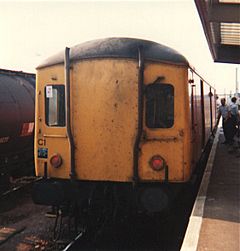British Rail Class 128 facts for kids
Quick facts for kids British Rail Class 128 |
|
|---|---|

55993 at Peterborough in the Late 1980s in Post Office Red Livery. Gangways have been removed.
|
|
| In service | 1959-1991 |
| Manufacturer | British United Traction |
| Family name | Parcels |
| Number built | 10 |
| Operator(s) | British Rail |
| Specifications | |
| Car length | 64 ft 6 in (19.69m) |
| Width | 9 ft 3 in (2.83m) |
| Maximum speed | 70 mph (112 km/h) |
| Weight | 40-41 tonnes |
| Prime mover(s) | Two Leyland 230 hp |
The British Rail Class 128 was a special type of train called a diesel multiple unit (DMU). These trains were built for British Rail to carry parcels and mail, not passengers.
They were introduced in 1959. Only ten of these unique trains were built by a company called British United Traction. Each train had two powerful 230 horsepower Leyland engines. The Class 128 trains were designed specifically for carrying packages. They had no seats for people. Instead, they were fitted with special racks for parcels and even areas to store bicycles. The last of these trains stopped running in 1991. Sadly, none of them were saved to be displayed in museums.
Contents
What Was the Class 128?
The Class 128 trains were part of a big plan by British Rail. This plan was to replace older steam trains with modern diesel trains. These new trains were quicker and more efficient. The Class 128 was unique because it was not for people. It was a "non-passenger" train.
Built for Parcels and Mail
These trains were very different from regular passenger trains. They had no windows along the sides. This was because there were no seats inside. Instead, the entire inside of the train was open space. It was filled with shelves and hooks. This design made it easy to load and unload many packages. They were like moving post offices on wheels.
Life on the Tracks
The Class 128 trains worked hard for many years. They traveled across the country. Their main job was to move mail and parcels between cities. They helped make sure letters and packages arrived on time. They were an important part of the postal service. These trains were often seen at busy railway stations. They would be loading or unloading goods.
End of the Line
By the late 1980s, things started to change. The way parcels and mail were moved around the country changed too. Other methods became more common. Because of this, the Class 128 trains were no longer needed. They were slowly taken out of service. The very last one was withdrawn in 1991. After serving for over 30 years, all ten trains were scrapped. This means they were taken apart. None were kept for future generations to see.
Images for kids


